Corrosion Inhibition of Carbon Steel Immersed in Standardized Reconstituted Geothermal Water and Individually Treated with Four New Biosourced Oxazoline Molecules
Abstract
1. Introduction
2. Materials and Methods
2.1. Carbon Steel, Corrosive Medium, and Electrochemical Methodology Used for BS-CIC Evaluation
2.2. Synthesis of Decenox (C10:1)
3. Results and Discussion
3.1. Temporal Evolution of the OCP, or Ecorr, of the CS-XC38 Electrode
3.2. Temporal Evolution of the Rp of CS-XC38 Electrode
3.3. Temporal Evolution of the Jcorr of the CS-XC38 Electrode, Deduced from Linear Polarization (Tafel Plots)
3.3.1. Cathodic Side Activity
3.3.2. Anodic Side Activity
3.4. Temporal Evolution of the Jcorr of CS-XC38 Deduced from Impedance Measurement
3.5. Study of the Adsorption and Adsorption Isotherms of Decenox (C10:1)
3.6. Discussion on the Role of Chain Length and the Presence of Unsaturation on IE
4. Conclusions
Author Contributions
Funding
Data Availability Statement
Acknowledgments
Conflicts of Interest
Appendix A
| Immersion Time (h) | 1 | 5 | 9 | 13 | 17 | 1 | 5 | 9 | 13 | 17 | ||||
|---|---|---|---|---|---|---|---|---|---|---|---|---|---|---|
| Inhibitor Name | Content (mg/L) | Icorr (Tafel) (µA) After 17 h of Immersion | IE on New Electrode via Jcorr (Rp) (%) | IE (%) Starting from the 1st Icorr Measured via Tafel Versus the 1st Jcorr (WI) over 44 min | Cathodic Constant of Tafel βc (mV) | Cathodic Constant of Tafel βa(mV) | ||||||||
| WI | 0 | 137 | 0.0 | 0.0 | 171 | 210 | 189 | 303 | 424 | 54 | 69 | 70 | 83 | 99 |
| C(10:1) | 10 | 29 | 58 | 34 | 118 | 81 | 859 | 80 | 78 | 73 | 87 | 76 | 69 | 661 |
| C(10:0) | 10 | 52 | 26 | 73 | 234 | 405 | 202 | 145 | 163 | 53 | 84 | 73 | 53 | 59 |
| C(11:0) | 10 | 62 | 10 | 94 | 152 | 122 | 223 | 178 | 240 | 91 | 83 | 70 | 72 | 88 |
| C(13:0) * | 10 | 11 | 84 | 92 | 132 | 144 | 152 | Nd | Nd | 74 | 91 | 80 | Nd | Nd |
References
- Rojas, J.; Giot, D.; Le Nindre, Y.M.; Criaud, A.; Fouillac, C.; Brach, M.; Menjoz; Martin, J.C.; Lambert, M.; Chiles, J.P.; et al. Caractérisation et Modélisation du Réservoir Géothermique du Dogger, Bassin Parisien, France, Rapport Final; BRGM R 30169 IRG SGN 89; BRGM: Orléans, France, 1989; p. 249. [Google Scholar]
- Castillo, C.; Ignatiadis, I. Sulfate-Reduction State of the Geothermal Dogger Aquifer, Paris Basin (France) after 35 Years of Exploitation: Analysis and Consequences of Bacterial Proliferation in Casings and Reservoir. In Proceedings of the 37th Workshop on Geothermal Reservoir Engineering Stanford University, Stanford, CA, USA, 30 January–1 February 2012; Curran Associates, Inc., Ed.; Stanford Geothermal Program, Stanford University: Stanford, CA, USA, 2012. [Google Scholar]
- Fardeau, M.-L.; Goulhen, F.; Bruschi, M.; Khelifi, N.; Cayol, J.-L.; Ignatiadis, I.; Guyot, F.; Ollivier, B. Archaeoglobus fulgidus and Thermotoga elfii, Thermophilic Isolates from Deep Geothermal Water of the Paris Basin. Geomicrobiol. J. 2009, 26, 119–130. [Google Scholar] [CrossRef]
- Lopez, S.; Hamm, V.; Le Brun, M.; Schaper, L.; Boissier, F.; Cotiche, C.; Giuglaris, E. 40 years of Dogger aquifer management in Ile-de-France, Paris Basin, France. Geothermics 2010, 39, 339–356. [Google Scholar] [CrossRef]
- Peter, F.; Ellis, I. A Geothermal Corrosivity Classification System. Trans.-Geotherm. Resour. Counc. 1981, 5, 463–472. [Google Scholar]
- Amalhay, M.; Akar, A.A.; Ignatiadis, I. Study of scale deposition phenomena Geothermal Wells in the Paris Basin. In Proceedings of the International Symposium, Geothermics 94 in Europe, from Research to Development, Orleans, France, 8–9 February 1994; BRGM, Ed.; BRGM: Orléans, France, 1998; pp. 223–232. [Google Scholar]
- Amalhay, M.; Ignatiadis, I. Comparative Study of the Effectiveness of Various Organic Surfactants in Inhibiting Carbon Steel Corrosion in a Natural Geothermal Environment by Using Rapid Electrochemical Tests. Mater. Sci. Forum 1998, 289–292, 169–180. [Google Scholar] [CrossRef]
- Hassan, A.; Numin, M.S.; Jumbri, K.; Kee, K.E.; Borhan, N.; Daud, N.M.R.N.M.; Nor, A.M.; Suhor, M.F.; Wahab, R.A. Density Functional Theory Studies on New Possible Biobased Gemini Corrosion Inhibitors Derived from Fatty Hydrazide Derivatives. ACS Omega 2023, 8, 23945–23952. [Google Scholar] [CrossRef] [PubMed]
- Österberg, M.; Henn, K.A.; Farooq, M.; Valle-Delgado, J.J. Biobased Nanomaterials—The Role of Interfacial Interactions for Advanced Materials. Chem. Rev. 2023, 123, 2200–2241. [Google Scholar] [CrossRef] [PubMed]
- Valentin, R.; Mouloungui, Z. Superhydrophilic surfaces from short and medium chain solvo-surfactants. Oléagineux Corps Gras Lipides 2013, 20, 33–44. [Google Scholar] [CrossRef][Green Version]
- Shenoy, P.; Kedimar, N.; Rao, S.A. A comprehensive review on anticorrosive behaviour of surfactants across diverse metals using multiple techniques: Current insights and future horizons. Chem. Eng. J. Adv. 2024, 20, 100645. [Google Scholar] [CrossRef]
- Betelu, S.; Helali, C.; Ignatiadis, I. Laboratory-Scale Implementation of Standardized Reconstituted Geothermal Water for Electrochemical Investigations of Carbon Steel Corrosion. Metals 2024, 14, 1216. [Google Scholar] [CrossRef]
- Helali, C. Sélection de Tensioactifs Biosourcés Pour L’inhibition de la Corrosion-Dépôt en Géothermie par L’évaluation Comparative de leur Action sur le Comportement Électrochimique de L’acier au Carbone: Du Laboratoire au Démonstrateur In Situ. Ph.D. Thesis, University of Toulouse ENSIACET-INP, Orléans, France, 2024; p. 358. [Google Scholar]
- Wiley, R.H.; Bennett, L.L. The Chemistry of the Oxazolines. Chem. Rev. 1949, 44, 447–476. [Google Scholar] [CrossRef]
- Frump, J.A. Oxazolines. Their preparation, reactions and applications. Chem. Rev. 1949, 44, 483–505. [Google Scholar] [CrossRef]
- Gant, T.G.; Meyers, A.I. The chemistry of 2-oxazolines (1985–present). Tetrahedron 1994, 50, 2297–2360. [Google Scholar] [CrossRef]
- Vračar, L.M.; Dražić, D.M. Adsorption and corrosion inhibitive properties of some organic molecules on iron electrode in sulfuric acid. Corros. Sci. 2002, 44, 1669–1680. [Google Scholar] [CrossRef]
- Chauhan, D.S.; Verma, C.; Quraishi, M.A. Molecular structural aspects of organic corrosion inhibitors: Experimental and computational insights. J. Mol. Struct. 2021, 1227, 129374. [Google Scholar] [CrossRef]
- Lin, B.; Zuo, Y. Corrosion inhibition of carboxylate inhibitors with different alkylene chain lengths on carbon steel in an alkaline solution. RSC Adv. 2019, 9, 7065–7077. [Google Scholar] [CrossRef] [PubMed]
- Porcayo-Calderon, J.; Regla, I.; Vazquez-Velez, E.; de la Escalera, L.M.M.; Canto, J.; Casales-Diaz, M. Effect of the Unsaturation of the Hydrocarbon Chain of Fatty-Amides on the CO2 Corrosion of Carbon Steel Using EIS and Real-Time Corrosion Measurement. J. Spectrosc. 2015, 2015, 184140. [Google Scholar] [CrossRef]
- Alrefaee, S.H. Effect of alkyl chain length and halide ions on the corrosion inhibition potential of imidazolium and pyridinium based ionic liquids: Computational studies. J. Mol. Liq. 2021, 344, 117848. [Google Scholar] [CrossRef]
- Frignani, A.; Zucchi, F.; Trabanelli, G.; Grassi, V. Protective action towards aluminium corrosion by silanes with a long aliphatic chain. Corros. Sci. 2006, 48, 2258–2273. [Google Scholar] [CrossRef]
- Ansari, K.R.; Quraishi, M.A.; Singh, A. Schiff’s base of pyridyl substituted triazoles as new and effective corrosion inhibitors for mild steel in hydrochloric acid solution. Corros. Sci. 2014, 79, 5–15. [Google Scholar] [CrossRef]
- Desai, P.D.; Pawar, C.B.; Avhad, M.S.; More, A.P. Corrosion inhibitors for carbon steel: A review. Vietnam J. Chem. 2023, 61, 15–42. [Google Scholar] [CrossRef]
- Viramontes-Gamboa, G.; Rivera-Vasquez, B.F.; Dixon, D.G. The Active-Passive Behavior of Chalcopyrite: Comparative Study Between Electrochemical and Leaching Responses. J. Electrochem. Soc. 2007, 154, C299. [Google Scholar] [CrossRef]
- Gabrielli, C.; Takenouti, H. Méthodes électrochimiques appliquées à la corrosion–Techniques dynamiques. Tech. L’ingénieur 2010, 810, 1–16. [Google Scholar] [CrossRef]
- Caldona, E.B.; Zhang, M.; Liang, G.; Hollis, T.K.; Webster, C.E.; Smith, D.W.; Wipf, D.O. Corrosion inhibition of mild steel in acidic medium by simple azole-based aromatic compounds. J. Electrochem. Soc. 2021, 880, 114858. [Google Scholar] [CrossRef]
- Srisuwan, N. Propriétés Inhibitrices D’un Mélange D’amines Grasses et de Sébaçate de Sodium Vis-à-Vis de La Corrosion D’un Acier Au Carbone; Institut National Polytechnique: Toulouse, France, 2008; p. 274. [Google Scholar]
- Reboul, M. Corrosion des alliages d’aluminium. Tech. L’ingénieur 2005, 325, 1–19. [Google Scholar] [CrossRef]
- Verma, C.; Quraishi, M.A.; Rhee, K.Y. Hydrophilicity and hydrophobicity consideration of organic surfactant compounds: Effect of alkyl chain length on corrosion protection. Adv. Colloid Interface Sci. 2022, 306, 102723. [Google Scholar] [CrossRef] [PubMed]
- Zhu, Y.; Free, M.L.; Woollam, R.; Durnie, W. A review of surfactants as corrosion inhibitors and associated modeling. Prog. Mater. Sci. 2017, 90, 159–223. [Google Scholar] [CrossRef]
- Popova, A.; Sokolova, E.; Raicheva, S.; Christov, M. AC and DC study of the temperature effect on mild steel corrosion in acid media in the presence of benzimidazole derivatives. Corros. Sci. 2003, 45, 33–58. [Google Scholar] [CrossRef]
- de Damborenea, J.; Bastidas, J.M.; Vázquez, A.J. Adsorption and inhibitive properties of four primary aliphatic amines on mild steel in 2 M hydrochloric acid. Electrochim. Acta 1997, 42, 455–459. [Google Scholar] [CrossRef]
- Li, X.; Xie, X.; Deng, S.; Du, G. Two phenylpyrimidine derivatives as new corrosion inhibitors for cold rolled steel in hydrochloric acid solution. Corros. Sci. 2014, 87, 27–39. [Google Scholar] [CrossRef]
- Hong, T.; Jepson, W.P. Corrosion inhibitor studies in large flow loop at high temperature and high pressure. Corros. Sci. 2001, 43, 1839–1849. [Google Scholar] [CrossRef]
- Saji, V.S. A review on recent patents in corrosion inhibitors. Recent Pat. Corros. Sci. 2010, 2, 6–12. [Google Scholar] [CrossRef]
- Buyuksagis, A.; Dilek, M.; Kargioglu, M. Corrosion inhibition of st37 steel in geothermal fluid by Quercus robur and pomegranate peels extracts. Prot. Met. Phys. Chem. Surf. 2015, 51, 861–872. [Google Scholar] [CrossRef]
- Aristia, G.; Hoa, L.Q.; Bäßler, R. Corrosion of Carbon Steel in Artificial Geothermal Brine: Influence of Carbon Dioxide at 70 °C and 150 °C. Materials 2019, 12, 3801. [Google Scholar] [CrossRef] [PubMed]
- El Brahim, I.; Lei, G. Azole-Based Compounds as Corrosion Inhibitors for Metallic Materials. In Azoles; Aleksey, K., Ed.; IntechOpen: Rijeka, Croatia, 2020; Chapter 5. [Google Scholar]
- Gutiérrez, E.; Rodríguez, J.A.; Cruz-Borbolla, J.; Alvarado-Rodríguez, J.G.; Thangarasu, P. Development of a predictive model for corrosion inhibition of carbon steel by imidazole and benzimidazole derivatives. Corros. Sci. 2016, 108, 23–35. [Google Scholar] [CrossRef]
- Gutig, C.; Grady, B.P.; Striolo, A. Experimental Studies on the Adsorption of Two Surfactants on Solid−Aqueous Interfaces: Adsorption Isotherms and Kinetics. Langmuir 2008, 24, 4806–4816. [Google Scholar] [CrossRef] [PubMed]
- Resende, G.O.; Teixeira, S.F.; Figueiredo, I.F.; Godoy, A.A.; Lougon, D.J.F.; Cotrim, B.A.; Souza, F.C. Synthesis of 1,2,3-Triazole Derivatives and Its Evaluation as Corrosion Inhibitors for Carbon Steel. Int. J. Electrochem. 2019, 2019, 6759478. [Google Scholar] [CrossRef]
- Srivastava, V.; Salman, M.; Chauhan, D.S.; Abdel-Azeim, S.; Quraishi, M.A. (E)-2-styryl-1H-benzo[d]imidazole as novel green corrosion inhibitor for carbon steel: Experimental and computational approach. J. Mol. Liq. 2021, 324, 115010. [Google Scholar] [CrossRef]
- Martinez, S.; Stern, I. Thermodynamic characterization of metal dissolution and inhibitor adsorption processes in the low carbon steel/mimosa tannin/sulfuric acid system. Appl. Surf. Sci. 2002, 199, 83–89. [Google Scholar] [CrossRef]
- Sliem, M.H.; Afifi, M.; Radwan, A.B.; Fayyad, E.M.; Shibl, M.F.; Heakal, F.E.-T.; Abdullah, A.M. AEO7 Surfactant as an Eco-Friendly Corrosion Inhibitor for Carbon Steel in HCl solution. Sci. Rep. 2019, 9, 2319. [Google Scholar] [CrossRef] [PubMed]
- Fragoza-Mar, L.; Olivares-Xometl, O.; Domínguez-Aguilar, M.A.; Flores, E.A.; Arellanes-Lozada, P.; Jiménez-Cruz, F. Corrosion inhibitor activity of 1,3-diketone malonates for mild steel in aqueous hydrochloric acid solution. Corros. Sci. 2012, 61, 171–184. [Google Scholar] [CrossRef]
- Zhu, Y.; Free, M.L.; Yi, G. The effects of surfactant concentration, adsorption, aggregation, and solution conditions on steel corrosion inhibition and associated modeling in aqueous media. Corros. Sci. 2016, 102, 233–250. [Google Scholar] [CrossRef]
- Malik, M.A.; Hashim, M.A.; Nabi, F.; Al-Thabaiti, S.A.; Khan, Z. Anti-corrosion Ability of Surfactants: A Review. Int. J. Electrochem. Sci. 2011, 6, 1927–1948. [Google Scholar] [CrossRef]
- Kern, P.; Landolt, D. Adsorption of organic corrosion inhibitors on iron in the active and passive state. A replacement reaction between inhibitor and water studied with the rotating quartz crystal microbalance. Electrochim. Acta 2001, 47, 589–598. [Google Scholar] [CrossRef]
- Öztürk, S.; Gerengi, H.; Solomon, M.M.; Gece, G.; Yıldırım, A.; Yıldız, M. A newly synthesized ionic liquid as an effective corrosion inhibitor for carbon steel in HCl medium: A combined experimental and computational studies. Mater. Today Commun. 2021, 29, 102905. [Google Scholar] [CrossRef]
- Ignatiadis, I.; Garnier, F.; Betelu, S. Étude Comparative de l’action de Différents Inhibiteurs de Corrosion-Dépôts Sur Le Comportement Électrochimique d’un Acier Au Carbone Dans Un Fluide Géothermal Reconstitué; Représentatif Du Dogger Du Bassin Parisien; Final BRGM/RP-64364-FR; BRGM: Orléans, France, 2015; p. 146. [Google Scholar]
- Hackerman, N.; Makrides, A.C. Action of Polar Organic Inhibitors in Acid Dissolution of Metals. Ind. Eng. Chem. 1954, 46, 523–527. [Google Scholar] [CrossRef]
- Yoon, S.K.; Choban, E.; Kane, C.; Tzedakis, T.; Kenis, P. Laminar flow based electrochemical microreactor for efficient regeneration of Nicotinamide cofactors for biocatalysis. J. Am. Chem. Soc. 2005, 127, 10466–10467. [Google Scholar] [CrossRef]



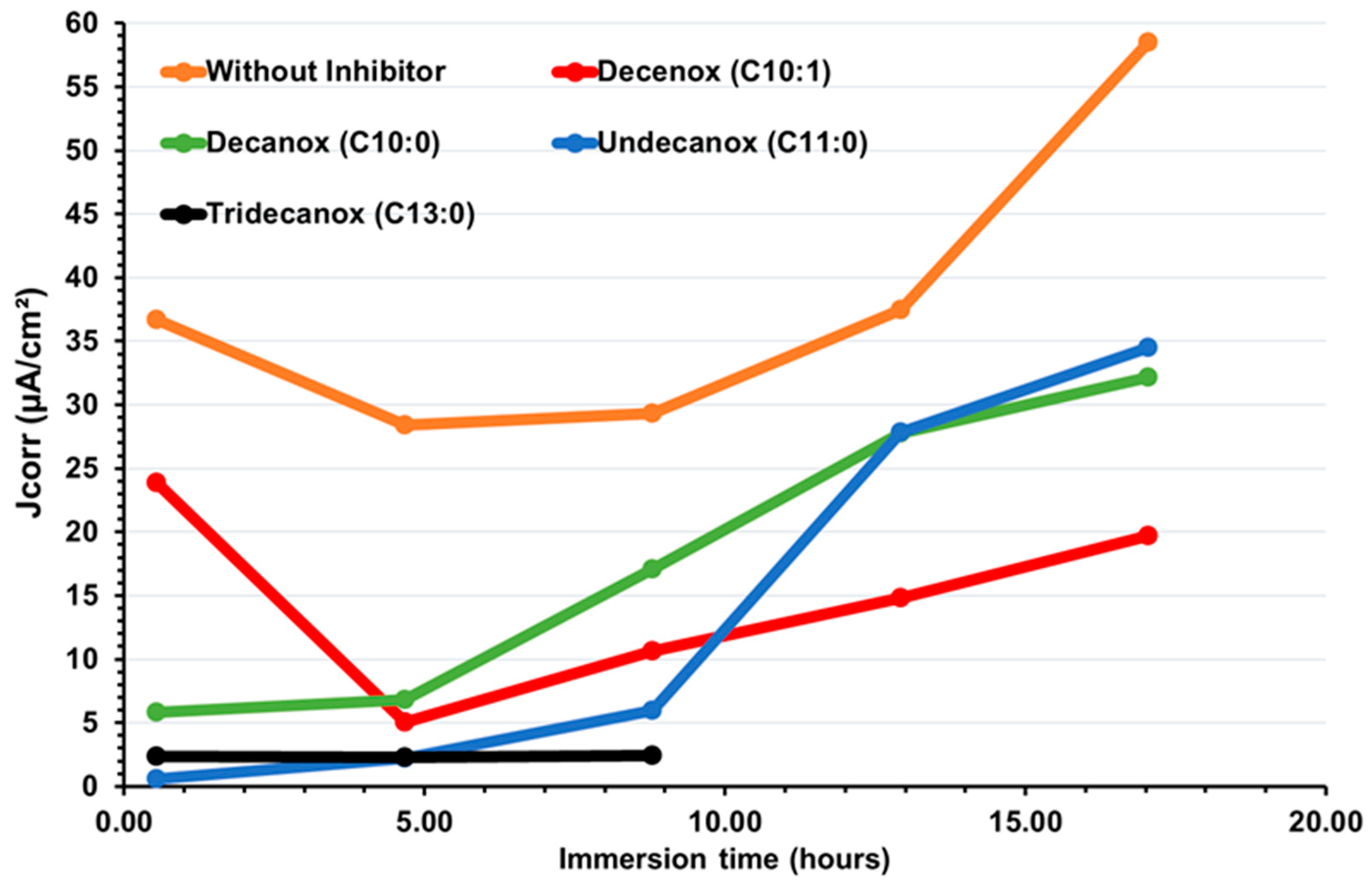
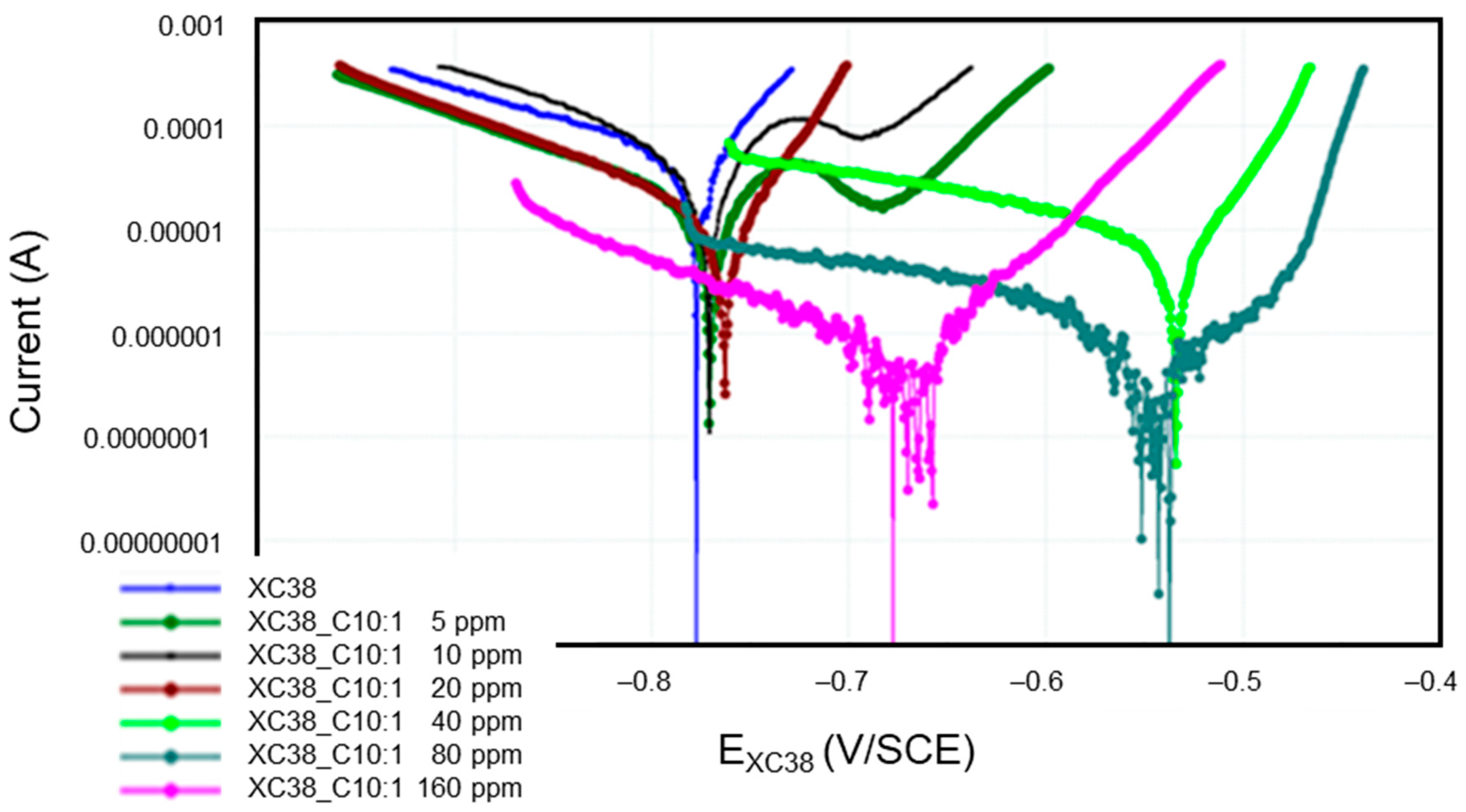

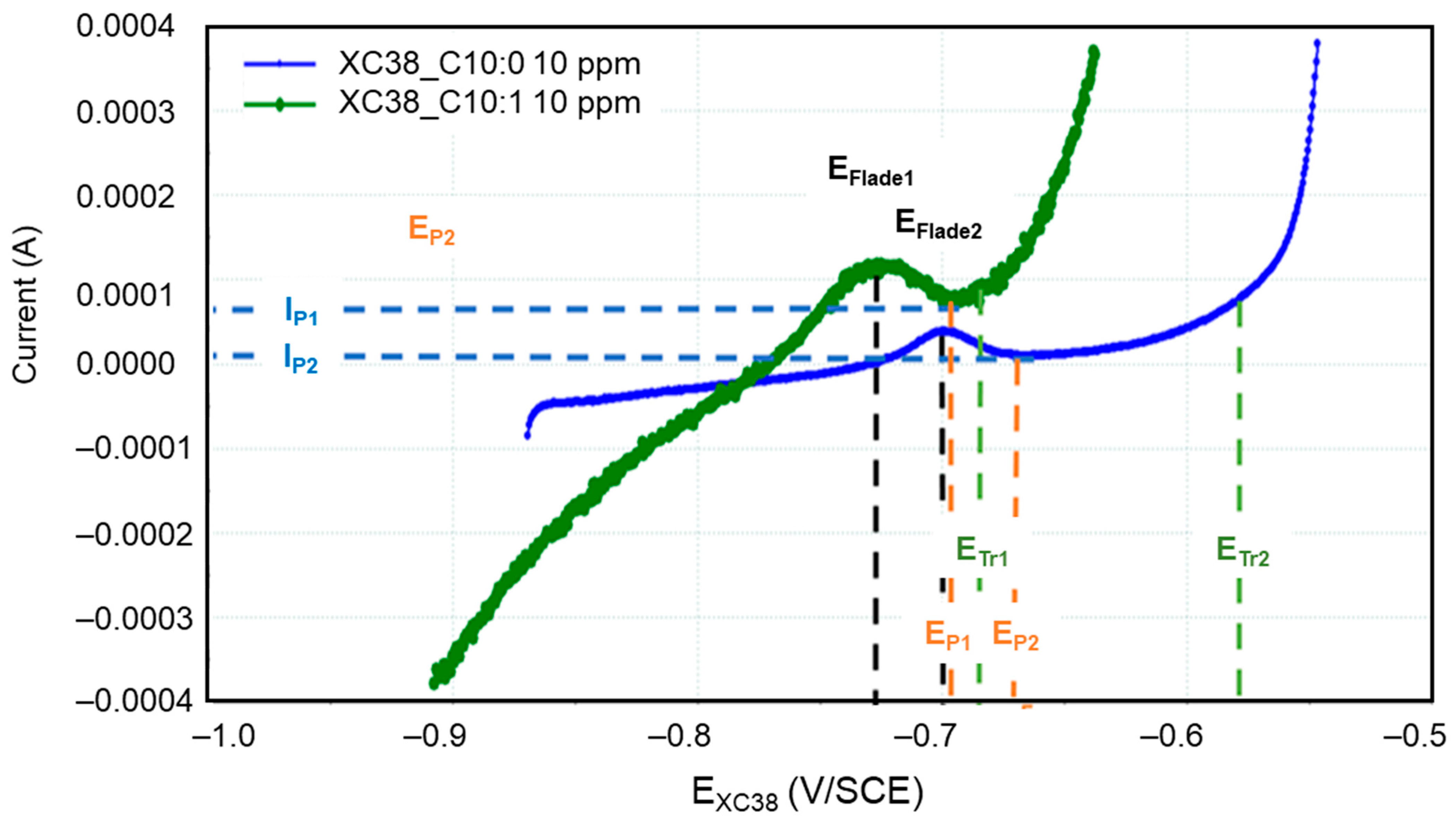


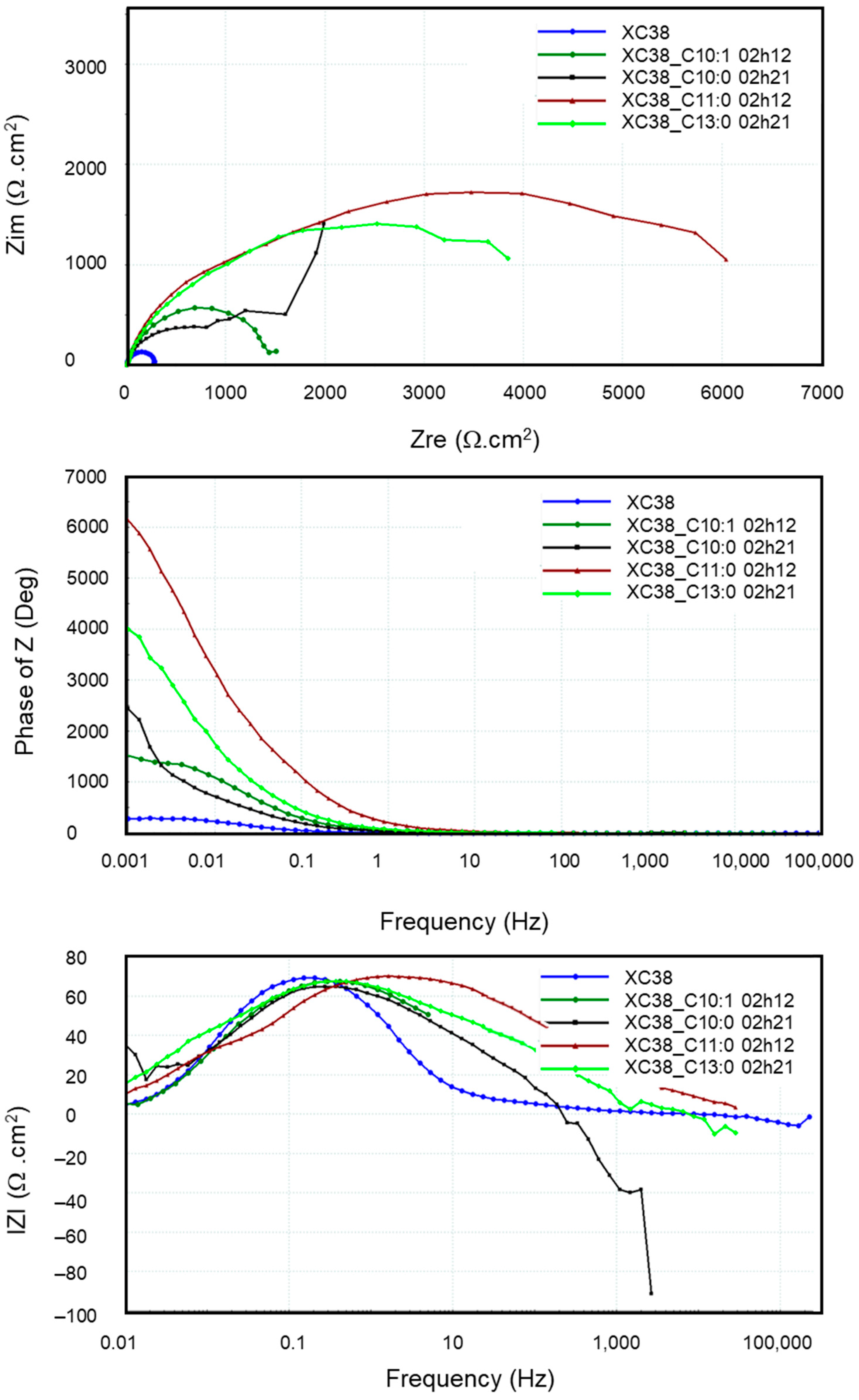
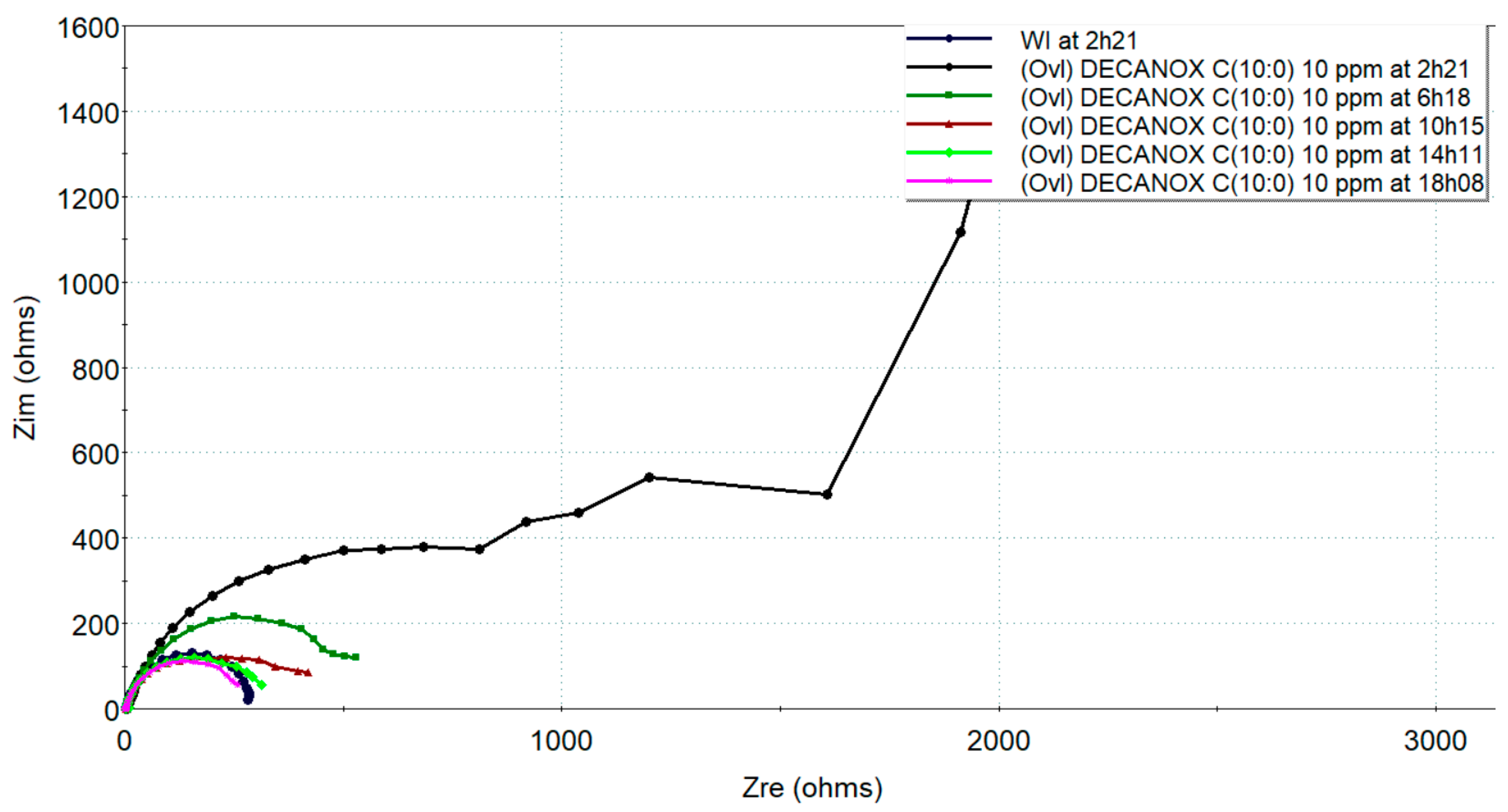

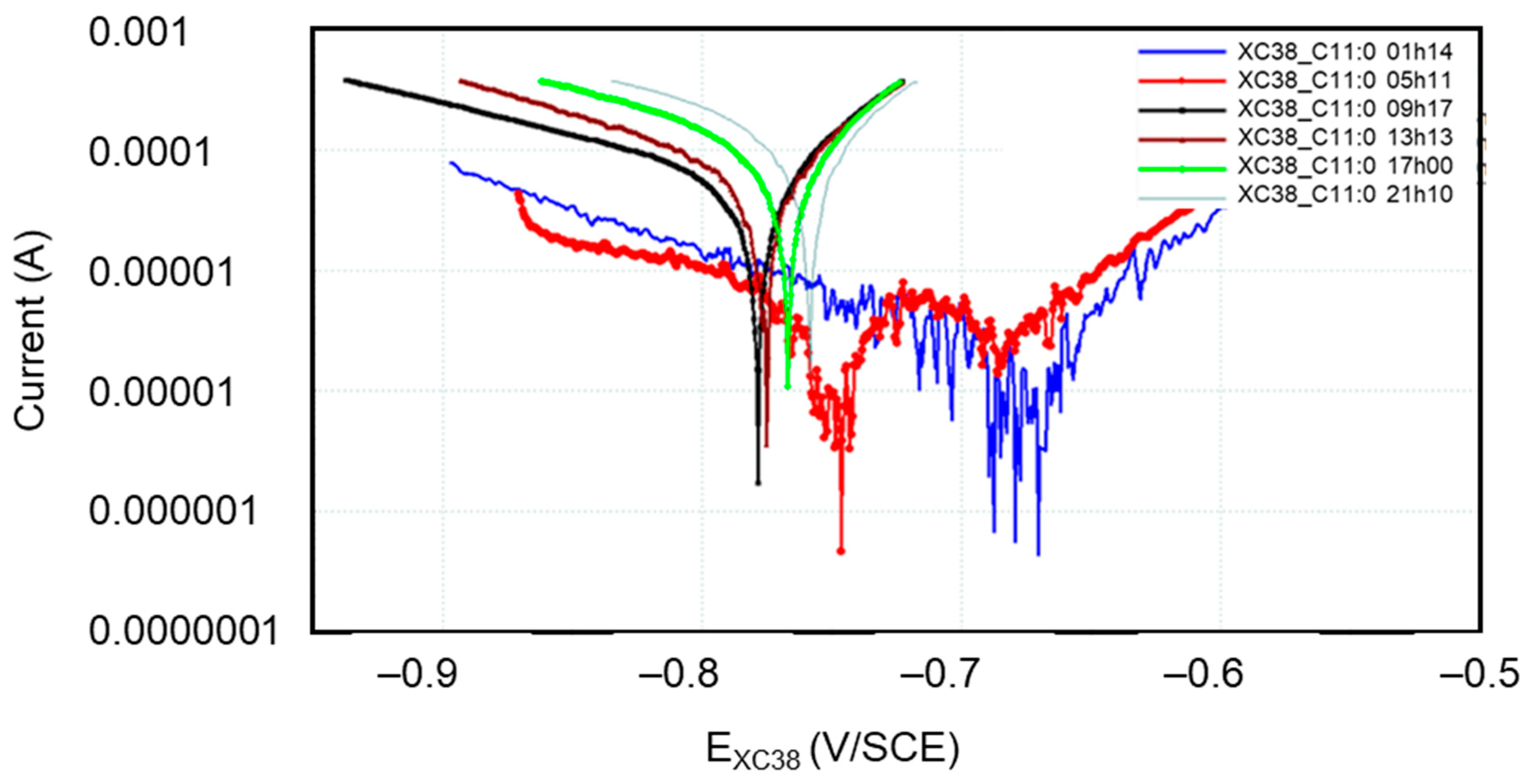
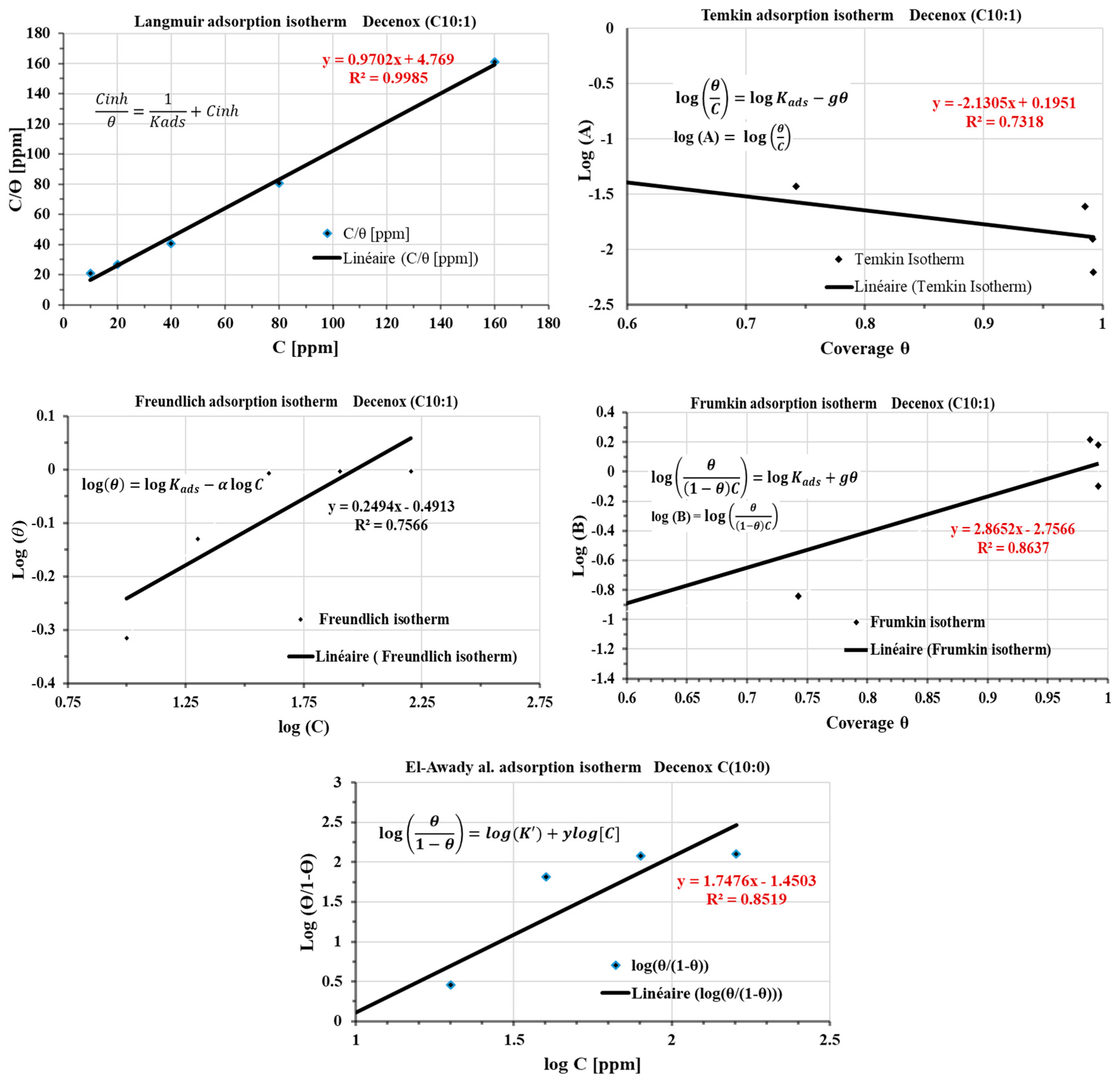



| BSCIC 2-Oxazoline Family | Aliphatic Chain Length | Presence of Double Bond on Aliphatic Chain | Expanded Structure |
|---|---|---|---|
| Decenox (C10:1) | 10 | 1 |  |
| Decanox (C10:0) | 10 | 0 |  |
| Undecanox (C11:0) | 11 | 0 |  |
| Tridecanox (C13:0) | 13 | 0 |  |
| Parameter | Without Inhibitor (WI) | Decenox (C10:1) | Decanox (C10:0) | Undecanox (C11:0) | Tridecanox (C13:0) |
|---|---|---|---|---|---|
| Content (mg/L) | 0 | 10 | 10 | 10 | 10 |
| Ecorr (0.33h) (mV/SCE) | −775.03 | −727.66 | −667.22 | −682.75 | −704.45 |
| ΔE1 (4h00) | −1.11 | −19.73 | −103.77 | −13.79 | 2.13 |
| ΔE2 (7h40) | 2.45 | −27.79 | −106.79 | −30.47 | −9.56 |
| ΔE3 (10h59) | 4.20 | −28.93 | −99.59 | −69.98 | −11.09 |
| ΔE | 0.00 | 47.37 | 107.81 | 92.28 | 70.58 |
| Name of Compound | Content (mg/L) | CCD Jcorr (Rp) (µA) | Average IE via Jcorr (Rp) (%) on New CS-X38 Electrode | IE (%) from Jcorr (Rp) Versus the 1st Jcorr (WI) at 44 min |
|---|---|---|---|---|
| Without inhibitor (WI) | 0 | 51.14 | 0.00 | 0.00 |
| C(10:1) | 160 | 3.79 | 92.6 | 97.9 |
| C(10:1) | 10 | 15.87 | 68.9 | 34.8 |
| C(10:0) | 10 | 24.73 | 51.6 | 84.0 |
| C(11:0) | 10 | 23.42 | 54.1 | 98.3 |
| C(13:0) (3 loops only) | 10 | 4.05 | 92.0 | 93.5 |
| Name of Compound | Content (mg/L) | Jcorr(Rw) Average at 17 h of Immersion (µA) | IE on CS-XC38 Electrode via Jcorr(Rw) at 17 h of Immersion (%) | IE on CS-XC38 Electrode via Jcorr(Rw) at 2 h17′ of Immersion (%) |
|---|---|---|---|---|
| Without inhibitor (WI) | 0 | 96.72 | 0.0 | 0.0 |
| Decenox (C10:1) | 10 | 29.7 | 69.29 | 85.06 |
| Decanox (C10:0) | 10 | 53.09 | 45.11 | 80.58 |
| Undecanox (C11:0) | 10 | 50.03 | 48.27 | 96.07 |
| Tridecanox (C13:0) (3 loops only) | 10 | 6.69 | 93.08 | 95.12 |
| Content (mg·L−1) | 1er Rp (Ohm) | θ | Kads (M−1) | R² | ΔG° (kJ/mol) | Rp (Average) (Ohm) | θ | Kads (M−1) | R² | ΔG° (kJ/mol) |
|---|---|---|---|---|---|---|---|---|---|---|
| 10 | 454.6 | 0.48 | 0.21 | 0.99 | −7.0 | 1115.1 | 0.78 | 0.31 | 0.99 | −7.53 |
| 20 | 912.5 | 0.74 | 1240.4 | 0.81 | ||||||
| 40 | 15,622 | 0.98 | 2266.8 | 0.89 | ||||||
| 80 | 28,643 | 0.99 | 4106.6 | 0.94 | ||||||
| 160 | 30,984 | 0.99 | 4732.0 | 0.95 |
| BSCIC Oxazoline Family (CHON) | Length of Aliphatic Chain | Presence of Double Bond on the Aliphatic Chain | Average IE (%) on New Electrode via Jcorr (Rp) over 17 h | IE (%) Starting from the First Jcorr Measured via Rp (Versus the First Jcorr(wi)) over 44 min |
|---|---|---|---|---|
| C10:1 | 10 | 1 | 68.9 | 34.8 |
| C10:0 | 10 | 0 | 51.6 | 84.0 |
| C11:0 | 11 | 0 | 54.1 | 98.3 |
| C13:0 (3 loops only) | 13 | 0 | 92.0 | 93.5 |
| Name of BSCIC | Content (mg/L) | Average IE (%) on New Electrodes via the Three Corrosion Currents, Jcorr(Rp), Jcorr(Tafel), Jcorr(Rw), over 17 h | Average IE (%) on New Electrodes via the Three Corrosion Currents, Jcorr(Rp), Jcorr(Tafel), Jcorr(Rw), over the First Hours of Immersion |
|---|---|---|---|
| C10:1 | 10 | 65.31 | 51.25 |
| C10:0 | 10 | 40.88 | 79.28 |
| C11:0 | 10 | 37.61 | 96.04 |
| C13:0 (3 loops only) | 10 | 89.80 | 93.46 |
Disclaimer/Publisher’s Note: The statements, opinions and data contained in all publications are solely those of the individual author(s) and contributor(s) and not of MDPI and/or the editor(s). MDPI and/or the editor(s) disclaim responsibility for any injury to people or property resulting from any ideas, methods, instructions or products referred to in the content. |
© 2024 by the authors. Licensee MDPI, Basel, Switzerland. This article is an open access article distributed under the terms and conditions of the Creative Commons Attribution (CC BY) license (https://creativecommons.org/licenses/by/4.0/).
Share and Cite
Helali, C.; Betelu, S.; Valentin, R.; Thiebaud-Roux, S.; Ignatiadis, I. Corrosion Inhibition of Carbon Steel Immersed in Standardized Reconstituted Geothermal Water and Individually Treated with Four New Biosourced Oxazoline Molecules. Metals 2024, 14, 1439. https://doi.org/10.3390/met14121439
Helali C, Betelu S, Valentin R, Thiebaud-Roux S, Ignatiadis I. Corrosion Inhibition of Carbon Steel Immersed in Standardized Reconstituted Geothermal Water and Individually Treated with Four New Biosourced Oxazoline Molecules. Metals. 2024; 14(12):1439. https://doi.org/10.3390/met14121439
Chicago/Turabian StyleHelali, Chahinez, Stephanie Betelu, Romain Valentin, Sophie Thiebaud-Roux, and Ioannis Ignatiadis. 2024. "Corrosion Inhibition of Carbon Steel Immersed in Standardized Reconstituted Geothermal Water and Individually Treated with Four New Biosourced Oxazoline Molecules" Metals 14, no. 12: 1439. https://doi.org/10.3390/met14121439
APA StyleHelali, C., Betelu, S., Valentin, R., Thiebaud-Roux, S., & Ignatiadis, I. (2024). Corrosion Inhibition of Carbon Steel Immersed in Standardized Reconstituted Geothermal Water and Individually Treated with Four New Biosourced Oxazoline Molecules. Metals, 14(12), 1439. https://doi.org/10.3390/met14121439







